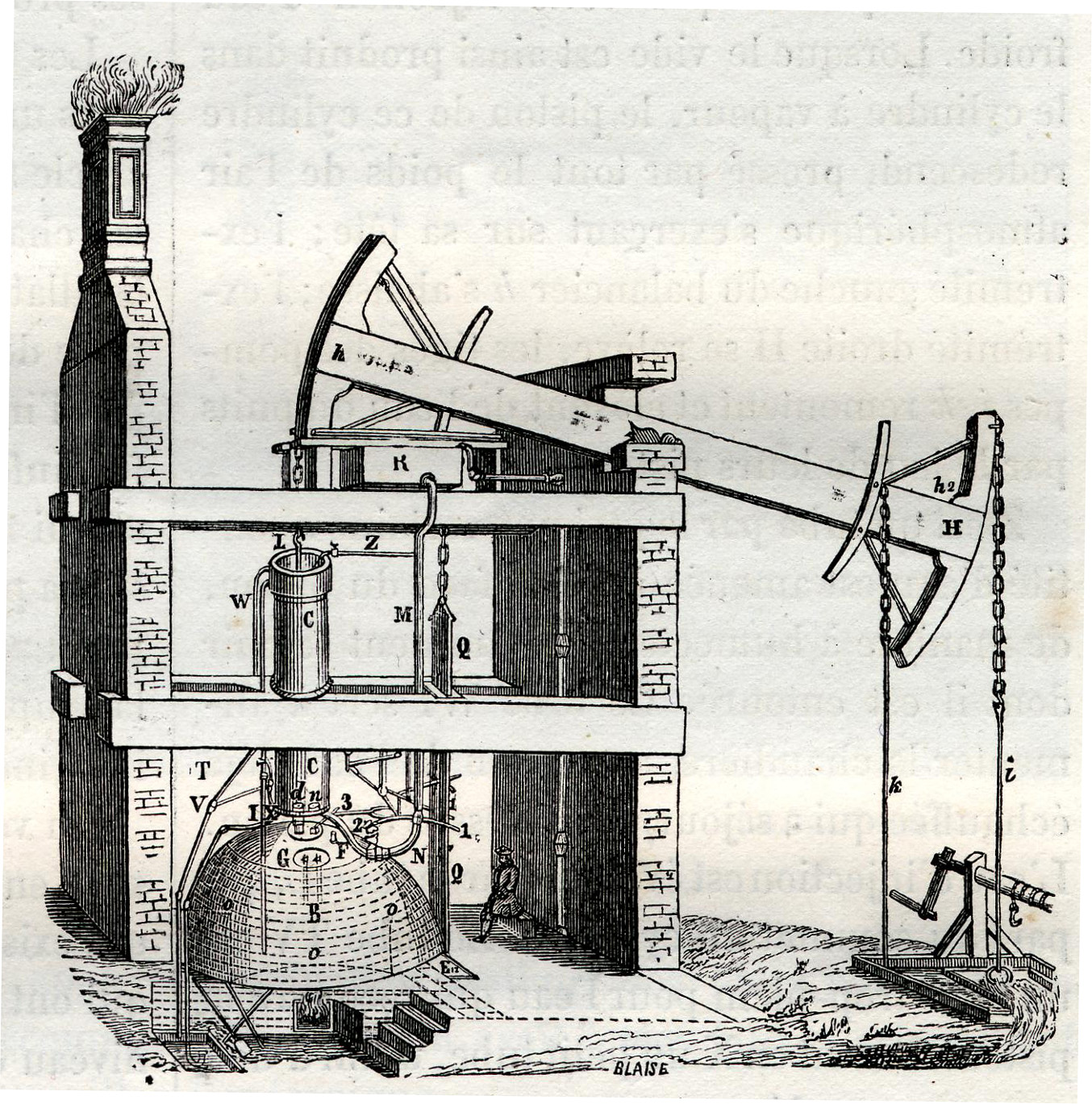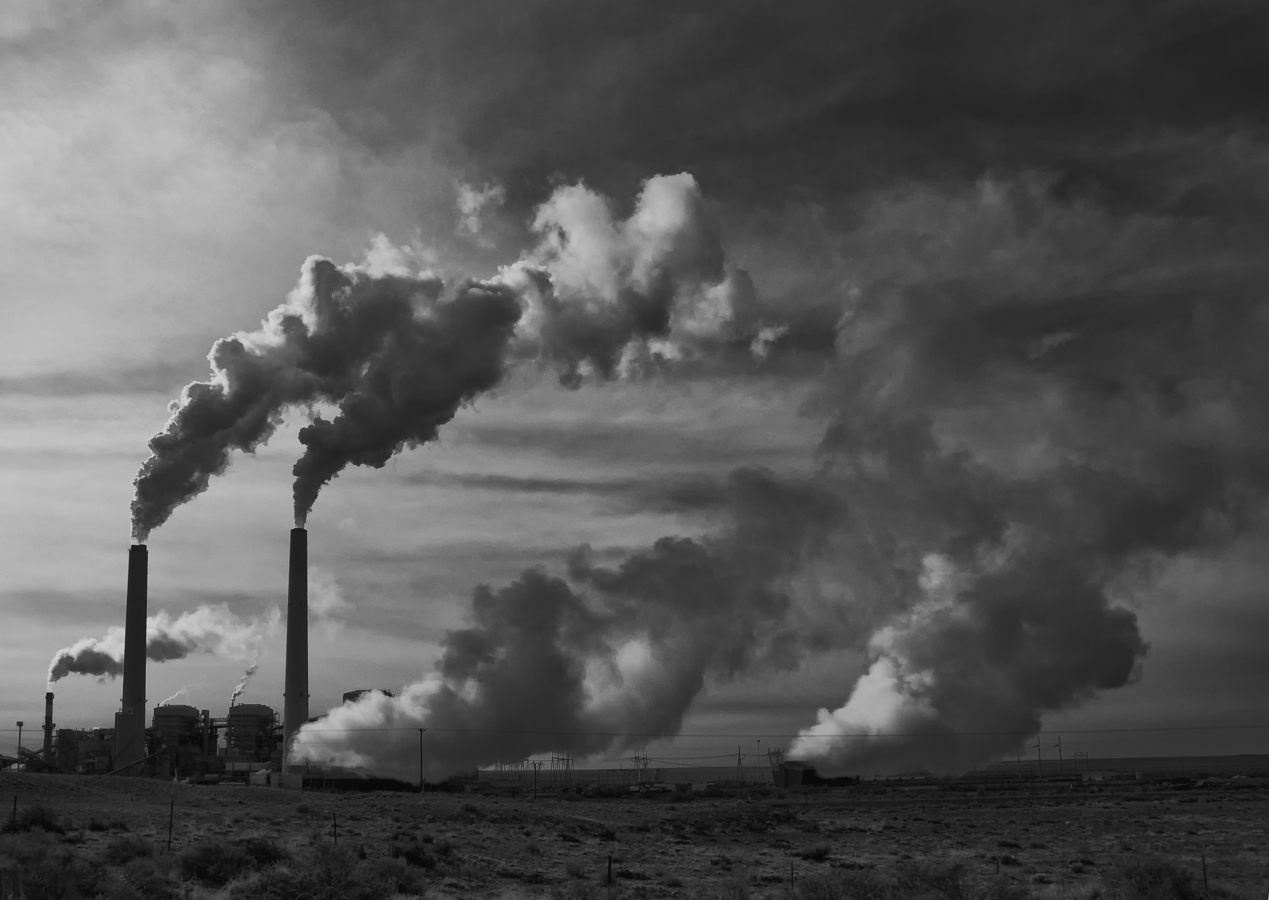
Time is running out for fossil fuels. Year 2023 marks the beginning of the end. Image: “Stopwatch” by Lookang, 2005. Creative Commons 3.0. Included with appreciation.
Note: this post is an excerpt from Renewing the World: Energy.
2023’s Conference of the Parties (COP28) marked the beginning of the end of fossil fuels used as an energy source, whether phrasing of “transitioning away” or “phasing out” prevailed. Fossil fuels are also known as biotic energy, referring to any life form that has ever lived: plants, animals, and all living things.

“End the Fossil Fuel Era Now” photograph by Matt Brown. Public Domain dedication, and included with appreciation to Matt Brown.
Origin of Biotic Energy – Fossil Fuels
245 million years ago, in the Mesozoic era, dinosaurs once roamed the planet. The Sun had already begun to trigger the evolution of plants whose chloroplasts could turn sunlight and carbon dioxide into sugars that served as the fuel for plant growth. Dinosaurs flourished, especially the large vegetarians like Apatosaurus, Brachiosaurus, and Diplodocus. With volcanic events, continents spread, climate differences invited new life forms, and bees spread plant life through pollination visits. Trees sprang up and with them arboreal animals.

“Triceratops” by Charles R. Knight, 1901. Courtesy of Smithsonian Museum. Public Domain CC0. Included with appreciation to Smithsonian and Charles R. Knight.
Then, sadly for children and paleontologists, dinosaurs died. Scientists call this the “Cretaceous Extinction.” A few dinosaurs morphed into other life forms, such as bird. But many laid down in the long sleep.
But dinosaurs are not really gone. Like all the animals and plants that have ever lived, they entered Earth’s soil where their remains were transformed by pressure and heat into compounds. The result? Dinosaurs, other animals and plankton became what we know today as natural gas and oil. In a similar process, plants became coal and peat.
It is ironic that we sometimes refer to an outdated model of a car as a “dinosaur.” Today, many would say that all vehicles powered by fossil fuels are dinosaurs. And, like Brachiosaurus and Triceratops, they’ll be going away.
Fossil fuel driven cars will soon be phantoms, like this elegant but obsolete Rolls Royce Phantom, circa 1952. Image: “Rolls Royce Phantom IV” by photographer, Usien. Creative Commons 3.0. Included with appreciation to Usien.
Last Sputtering Cough – Climate Disasters and Health Problems
The year 2023 was the warmest on record. Storms and floods caused deadly, and expensive, destruction. Droughts and wildfires desiccated and devastated habitat of wildlife, people, and countless acres of agricultural land and carbon-absorbing forests.Biotic energy or fossil fuels, are at once the largest carbon sequestration storage mechanism on Earth and also the biggest threat to life on Earth. When carbon-based life forms release their energy source, gases like carbon dioxide, methane, and other so-called greenhouse gases, enter the atmosphere to form a blanket that is slowly but clearly warming the planet.

Climate change, driven by burning fossil or biotic fuels, causes drought leading to wildfires, land loss, and air pollution. Image: “WIldfire in Arizona, USA: 2020” by Mike McMillan, USFS. Creative Commons 0, public domain. Included with appreciation.
Time to stop using this ancient, and modern, source of energy. The presenting reason is obvious: insurance companies are pulling out of areas where climate-related damage has occurred too many times to rebuild, climate migrants are leaving untenable areas, coastal locations are coping with floods, arid areas are running out of water. Skies are grey with particulate matter that clogs air and airways. Coughs and pulmonary diseases are the soundtrack that is bringing the fossil fuel era to a sputtering stop.

Air pollution is a major cause of pulmonary diseases. Image: “Beijing smog” by photographer Bobak, 2005. CC2.5. Included with appreciation.
Coal Hard Facts – Supply Running Out
But there is another reason that it is time to stop . We will soon run out of coal, oil, natural gas, and other forms of fossil energy. World Coal Association, now rebranding as FutureCoal – The Global Alliance for Sustainable Coal (and let’s note they are advocates) estimates global coal will last 133 years. Amounts of reserves, and time, vary by country. For example, the United States might have as many as 400 years left to mine the existing 250 billion metric tons but other countries like Brazil have just 11 billion metric tons. What about oil, seemingly so abundant it gushes from the earth? About 47 years.
Year 2023 will mark the transition from biotic energy to abiotic forms like sunlight, wind and other elements that are not just renewable but seemingly infinite. It will be an advance in civilization. As that transition happens, let’s take a look at biotic – fossil fuel – energy to see how we got here, and how we might transition. Because, while fossil or biotic energy forms might be outdated, they may leave us some gifts in their passing. This exploration emphasizes those benefits. Think of it as using leftovers.
COAL

“Burning coal” by photographer diddi4. Dedicated to the public domain CC0. Included with appreciation.
Burning coal is the release of time—but it’s also a time bomb.
Coal that is burned now releases carbon that was captured and contained millions of years. When dinosaurs traversed prehistoric Earth, they chomped and stomped on vegetation. Ancient plants grew in the same way as today, absorbing sunlight, water, and CO2. And, as they do today, ancient plants released oxygen. Those bushes, grasses, plants, and trees eventually withered, died, and became buried over time in layers upon layers of soil. As they decomposed, their carbon life components (carbon dioxide CO2 and methane CH4) were released.
But not all plants decayed completely. If they became too deeply buried to allow their components to release, then they retained their life-forming carbon instead. As time went on, layers of new soil piled up on those plants, compressing and hardening them into what we recognize as coal.
How Did Humans Begin Burning Coal?
The earliest humans, seeking warmth and light, burned wood. As populations increased and forests became less abundant—or if no trees grew nearby—people sought an alternative. Coal chunks sometimes emerged from underground deposits. Somebody discovered it was burnable.

“Cooking fire” by photographer reivax, 2011. Creative Commons 2.0 Included with appreciation.
The earliest use of coal for warmth and light could perhaps be traced to China. Archeological evidence in that area indicates surface mining of coal and household use approximately 3490 BCE. The Greek philosopher Theophrastus described stones used by Roman blacksmiths to heat forges. When Romans invaded England as early as 43 CE, they found coal fields and used them well. Around 1550 CE, some households began to burn coal indoors. Yes, the house reeked and the walls were black with soot, but it worked.
Coal Mining

“Coal mining” circa 1871. Illustration by M.W.R. in The Graphic. Public Domain. Included with appreciation.
At first, coal mining was easy. Coal could be found just by digging a shallow pit, then lifted out of the pit in a basket. Demand for coal grew. Households, as well as blacksmiths and glassblowers who needed heat to work their crafts, demanded greater amounts of coal. Soon mines were excavated 165 feet (50 meters).

Thomas Newcomen’s invention changed the coal industry, allowing excavations to greater depth. Some credit Newcomen’s design with starting the Industrial Revolution. Image: “Newcomen Figuer” illustration, 1868. Public Domain. Included with appreciation.
The use of coal today may have been advanced by British inventor Thomas Newcomen who, in 1712, designed a steam machine that drained water from deeper coal mines, thus encouraging even more coal mining. Many believe Newcomen’s engine began the Industrial Revolution, largely powered by coal.
Types of Coal

“Coal Ranking System used by U.S. Geological Survey” by Stanley F. Schweinfurth. Creative Commons 0, public domain. Included with appreciation.
Not all coal is equal. There are different types:
Anthracite — highest grade, with largest amount of fixed carbon and lowest portion of volatile matter.
Bituminous — medium grade, between anthracite and sub-bituminous, has the highest heating capability.
Sub-bituminous — greater heating value than lignite.
Lignite — lowest grade, brown not black, least amount of carbon.
(Source: Society for Mining, Metallurgy & Exploration. “Coal’s importance to the world.” 2023.)
Largest Surface Coal Mines

North Antelope Rochelle Coal Mine, as seen from the International Space Station, 2005. At that time, coal from the site was carried by 2,000 rail cars – every day. Image: NASA, ISS,. Public Domain. Included with appreciation.
Where does most coal come from? Here are some of the world’s largest mines (2021 figures):
North Antelope Rochelle Mine, Wyoming, USA
Owned by Peabody Energy Corp. https://www.peabodyenergy.com/Operations/U-S-Mining/Powder-River-Basin- Mining/North-Antelope-Rochelle-Mine
Black Thunder Mine – Wyoming, USA
Owned by Arch Resources Inc. https://www.archrsc.com/our-business/operations/
Sangatta Mine
East Kalimantan, Indonesia
Owned by PT Bumi Resources Tbk http://www.bumiresources.com/en
Gevra OC Mine Chhattisgarh, India Owned by Coal India Ltd https://www.coalindia.in
Bogatyr Komir Mine
Pavlodar, Kazakhstan
Owned by Samruk-Energy https://www.samruk-energy.kz/en/
Source:
Global Data “Global: Five Largest Surface Coal Mines in 2021.” https://globaldata.com/data- insights/mining/global—five-largest-surface-coal-mines-in-2090683/
Coal Supply

Biotic energy supplies will run out, including the world’s coal. Image: “Hourglass,” courtesy of Wellcome Trust, UK. Museum # A113000, photo #L0011338. Creative Commons 4.0. Included with appreciation.
Even if we wanted to continue mining and burning coal for energy, supplies do have limits. While coal mining has continued for centuries, easy-to-reach deposits have been depleted, and mining is becoming more difficult. Then there is the question of when the supply of coal will officially run out. It won’t be any time soon but it will happen.
Here’s an estimate of global coal deposits:
United States – 251 billion metric tons
Russia – 157 billion metric tons
China – 115 billion metric tons
India – 92 billion metric tons
Western Eurasia – 91 billion metric tons
Australia and New Zealand – 79 billion metric tons
South Africa – 47 billion metric tons
Brazil – 11 billion metric tons
Source: American Museum of Natural History, 2023.
The figures above are for land-based coal. Some research indicates that there may be coal in areas of the sea bed where carbonized plant matter may be present. So far, however, deep sea-bed mining has been more focused on discoveries of cobalt and other minerals.
And For How Long?
According to the World Coal Association, the world has enough coal reserves to last 133 years. Other estimates vary by country: for example, coal reserves in the United States might last over 400 years (World Coal Association, 2023).
Burning Issue

“Cholla Power Plant near Joseph City, Arizona, USA” by PD Tillman, 2010. Creative Commons 2.0. Included with appreciation.
Many economies still depend on it. But at the same time, most environmentalists, national leaders, public health professionals, and scientists are committed to phasing out coal, even before the resource itself is depleted. Here are some reasons why:
- CO2 — the average coal-fired plant sends six million tons of carbon dioxide into the atmosphere every year of its operation. Coal produces 1.5 times more CO2 than oil and two times more than natural gas.
- Toxins — when burned, coal also releases toxic heavy metals.
- Radiation — ignited coal gives off more radiation than nuclear power.
- Acid Rain — burning coal releases sulfur dioxide (SO2) and nitrogen oxide(N2O) into the air, causing acid rain.
- Disease and Death — more people died in United States’ coal mines than allthose who died in the Vietnam war, Gulf war, and Iraq war combined.
SOLUTIONS AND INNOVATIONS
Reducing and eliminating the use of coal will be a phase-out process. In 2023, it was still the source for one-third of all electricity generation in the world. Also in 2023, meeting in Dubai for COP28, representatives from more than 200 countries pledged to phase out use of fossil fuels, with coal first on the agenda. The world that burns coal agreed, in principle, to stop.
The most important solution is cessation. That will take some time. Meanwhile, there are actions we can take. These refinements are worth attention.
Closing Coal Mines
Coal mines may close because it is very expensive to dig big holes. Image: “Dollar sign in circle” by graphic designer Jonathan Svenson Glad, 2014. CC0 Public Domain. Included with appreciation.
According to a recent study (Marcacci, 2022), coal mines may close not just because they are harmful to the environment—both land and atmosphere—but because it is more expensive to dig big holes, pull up heavy coal rocks, crush and process them, transport heavy loads of coal, and burn them in dedicated plants that are costly to build, maintain, and staff. Compared to solar or wind, coal cannot compete.
In some economies, coal mining and coal burning have been on the decline. For example, in the United States, the coal industry has continually declined since its peak in 2011. During that time, the percentage of coal used for American electricity generation fell from 50% to 20% (a brief rebound occurred during the Covid pandemic). But the fact remains that 80% of U.S. coal plants cost more to maintain than to replace with new forms of energy generation. Moreover, regulations will accelerate closings: 2028 laws to protect drinking water from coal ash and other toxins may make compliance prohibitively costly. Duke Energy Company (USA) announced its intention to close 11 coal-fired power facilities earlier than expected, at the same time declaring a move to invest in renewable energy. Georgia Power (USA) stated it would close all of its 14 coal plants by 2035 while pivoting to solar and wind. Peabody Coal, the world’s largest private company in the coal business, announced its program of investment in solar and storage (Marcacci, 2022).
Coal Carbon Capture

“Biofilm for Carbon Capture” by U.S. Department of Energy, 2012. Public Domain. Included with appreciation.
There are numerous naysayers who believe that carbon capture is an excuse to continue using fossil fuels. That may be a motive for some who wish to preserve existing coal operations, both mining and coal-fired power generation plants. However, every year we continue to burn coal for power generation, we send 15 billion tons of carbon dioxide into the atmosphere. That’s where so-called “clean coal” comes into the discussion.
It is certain that the world will phase out of coal use, but while it continues to burn coal, it is wise to limit environmental damage. Some methods exist, but more are needed. There are ways to “wash” coal to reduce the emissions from ash and sulfur dioxide during coal combustion. We have methods for flue gas desulfurization that limit the amount of sulfur dioxide released by as much as 97%. Combining these two processes leads to a method called “ultra-clean coal” (UCC) which may reduce ash to 0.25% and further reduce sulfur.
But problems concerning waste exist. There are technologies for capturing carbon dioxide from gas that could be adapted to coal. There is a market for collecting carbon dioxide for use in industry, but this worked against reducing CO2. That fact leads to the reality that unless something has economic value, innovation is slow to develop new methods. A question for those who are engineering, scientific, and technological experts is how to reduce coal emissions in a way generates profit, not expenses.
In the United States, in 2023, there were 15 CCS facilities actively pulling in carbon dioxide for storage; another 121 were in construction. Altogether, these CCS facilities could capture 3% of CO2 emissions. It should be noted, however, that many CCS projects use the collected CO2 to inject into existing oil wells, aiming to force out more crude. American industry receives tax credits for using CCS: from 2010 to 2019, businesses negotiated $ billion in credits, and were on target to claim $5 billion more from 2023 to 2027. Once captured, if the CO2 is not used to pump more oil from almost-depleted wells, it is channeled into pipelines and ultimately stored underground.

“Daniel on the Pipeline” by photographer Ryan McFarland, 2008. Creative Commons 2.0. Included with appreciation.
Carbon dioxide pipelines may pose problems. Significant pressure is needed to convert CO2 to a liquid that can enter a pipe. If the pipe leaks or is damaged, environmental and health hazards are certain to follow. Consider this example: Wolf Carbon Solutions/ADM and Navigator CO2 Ventures are two companies working in carbon dioxide transport and storage in Illinois. The Navigator pipeline stretches 1,350 miles (2,172 kilometers) as it moves through Illinois’s 14 counties and across states including Iowa, Minnesota, Nebraska, and South Dakota. The goal is to store the CO2 in the Mt. Simon Sandstone Foundation in Illinois. The Wolf Carbon/ADM pipeline is smaller: 280 miles (450 kilometers). That pipelines runs from Iowa through 10 counties in Illinois before its CO2 is stored. Wolf/ADM plans to expand into other areas. Why were both pipelines sited in Illinois? That state passed a Carbon Dioxide Transportation and Sequestration Act that supports CCS, and therefore permits use of land made available through eminent domain.
Value Proposition?
Image: “Balanced scale of justice” by Perhelion, 2011. Dedicated to the public domain. Included with appreciation.
Capture and storage are expensive, even if the cost is eased by tax credits. Is there a way to make CO2 into a valuable commodity? According to a 2023 MIT study, there could be value but it comes down to supply and demand. The world spews out a lot more CO2 than it captures. Some of it can be used, for example, in carbonated drinks to make bubbles. But how many spritzers can one consume? And, when the bottle or can is unscrewed or opened, that burst of fizz goes right back into the air. Flower and plant growers buy CO2 for use in their greenhouses to help plants thrive, but that is a small market. There are technologies for turning CO2 into plastic, but they are energy-intensive, so until we use only non-emitting energy sources, those plastics are part of the problem. Those who capture CO2 either use it for “enhanced” oil recovery or they bury it. In both instances, there may be a tax credit. In the U.S., companies get $60 per ton for enhanced oil draw, and $25 more if they bury it underground.
Underground Carbon Sequestration

Oman, plenty of peridotite and plenty of opportunity. Image: “Muscat, Oman” by photographer Safa Daneshvar, 2022. CC4.0. Included with appreciation.
As the world transitions away from fossil fuels used for energy, there will be additional innovation and development of techniques for carbon sequestration. Storage underground requires significant energy and considerable environmental disturbance. New approaches using mine tailings or peridotite (a mineral containing olivine and pyroxene), when combined with water and CO2, mineralize carbon dioxide quickly and permanently. The technology first appeared in Oman, where it was observed that when rainwater fell on peridotite, carbonated fluid flowed in and fused into rock seams. A new company 44.01, launched in Oman where one of the world’s largest peridotite deposits is located, explored the opportunity. That company collected CO2 via direct air capture (DAC), not by pipeline. Support appears to be growing: in 2022, the company received the Earthshot Prize in the category “Fix Our Climate” (Brooke, 2023).
Coal Mine Methane (CMM) Emissions: Danger and/or Opportunity?

“Methane” by University of Göttigen and U.S. Geological Survey, 2016. Public Domain. Included with appreciation.
Methane an extremely potent greenhouse gas that is exacerbating climate change. It is also a potential energy source that could be used for electric power generation, or even to power cars. We can do more than stop methane emissions; we can reuse them. It will be some time before we completely transition from coal mining. During that period, there are things we could be doing. Here’s one: methane capture and reuse.
The Global Methane Pledge, introduced in 2021 at COP26 in Glasgow, Scotland, aimS to reduce methane emissions as quickly as possible. Reducing methane is a critical next step in reaching climate goals because, despite its powerful destructive properties when released into the atmosphere, methane is also short-lived. So stopping methane emissions is both fast and immediately effective. More than 111 countries have signed a Global Methane Pledge to reduce methane emissions by 30% below 2020 levels by 2030. China and the United States developed a joint declaration, promising to collect and compare methane emissions and reduction solutions.. The signatory nations are responsible for 45% of methane emissions. The effect of the Pledge, if and when complete, will be similar to climate improvements if the whole transport sector—from cars to aircraft—were to achieve net zero emissions.
Methane is present in coal mines. It is released during the mining process, both from the coal and also from the rock layers around the coal. Miners know its power: explosive when mixed with air, methane has caused loss of life. Methane is present in active mines and is found in ventilation systems. Methane is also in abandoned mines, old vent pipes, and boreholes. It can also be found in surface mines. However, most methane comes from underground coal mines.
There are presently more than 200 coal mine methane capture-and-reuse projects that are either in operation or planned. Here’s a summary of how CCM capture and reuse worked in one unlikely location—a ski resort.
|
Elk Creek Mine in Somerset, Colorado, located in an old mining area, powers a resort owned by Aspen Skiing Co., a enterprise that had already built a solar array and a small hydroelectric power plant using snowmelt. But ski country is worried: skiing depends on snow, and global warming is making that harder to predict and keep in good condition to attract skiers who pay for access to the slopes and spend liberally at hotels, restaurants, and shops. Since 1980, Aspen’s winter ski season has operated a full month less. Every year snow is low, the ski industry also sees lower revenues—a loss of $1 billion per season. Aspen Skiing Co. approached Oxbow Carbon, owned by William Koch, with a proposal to build a methane capture and reuse plant at the Elk Creek Mine. The operation pulls and filters methane, uses it to generate electricity, and sends it to the grid where Holy Cross Energy handles distribution. Koch agreed to the project, seeing it as a good investment. The methane capture and reuse operation produces $100,000 to $150,000 per month from a combination of electricity and carbon-credit revenues. The starting investment was $534 million. |
Can Aspen be a model for future energy projects? There is potential, but there are also roadblocks, including acquisition of rights, and navigating regulations for electricity market access. Laws play an important role: permits from the Colorado Outdoor Recreation and Economy Act to lease methane from abandoned mines are an example.
Here’s another example. China’s coal mines release 15 billion to 20 billion cubic meters of methane each year. The deeper a coal mine is dug, the more methane is released, so numbers also will rise. China’s Coal Mine Methane Development Project, a joint program with the Asian Development Bank, Government of the PRC, and the businesses of Shanxi Province, built systems that capture coal mine methane and use it to power businesses and homes. The methane captured is about 90%.

Global Methane Initiative and Pledge may help to meet goals of the Paris Agreement. “Global Methane Initiative logo,” courtesy of https://www.globalmethane.org. Fair use license. Included with appreciation.
United Nations’ initiatives to reduce methane emissions resulted in a series called “Methane Mondays.” Interviews and presentations by experts are available in online videos. Methane should receive even more focus as climate problems increase, and as coal phases out of the energy array. Using coal mines—active or closed—to capture and harness methane for cleaner energy will be a technology to watch for the future.
Repurposing Coal Plants – Making Bitter a Bit Better
It is, for some, a bitter truth that coal must be phased out and coal plants must close. Communities, jobs, and other economic and social realities may be disturbed in the transition. But there may be more opportunity if coal-fired plants are repurposed.

Energy Sector Management Assistance Program, United Nations, logo. Courtesy: ESMAP, UN, 2012. License: Fair Use. Included with appreciation.
World Bank Group’s Energy Sector Management Assistance Program (ESMAP), in a team led by Debabrata Chattopadhyay and Chandrasekhar Govindrajalu and other experts from Stanford University, Lawrence Berkeley National Lab, the Center for Climate Finance and Investment at Imperial College, and the Indian Institute of Management, conducted a study of the relative benefits of decommissioning versus repurposing coal plants.
Decommissioning (i.e., closing) a coal plant has economic and social consequences that affect the lives and livelihoods of the community. People had jobs in the plants, or businesses that supported the plants and workers. The business paid taxes. Power generation empowered businesses, homes, hospitals, schools, and infrastructures like traffic signals and street lights.
Consideration needs to be given to find a substitute for energy generation and delivery if a coal plant closes. Equally important, the workers at the plant would need assistance with transitioning to another job.
Repurposing an existing coal plant seems better for everyone, and several options could be applied. ESMAP proposed repurposing coal plants for continuing energy generation by providing renewable power such as solar photovoltaic, solar thermal, wind, or biomass. More options include storage via battery, solar thermal, pumped hydropower, and synchronous condensers (SynCON).
Each of these repurposing options had some costs, but in most cases costs are well balanced or exceeded by resulting benefits. Choosing from among the many repurposing options, the ESMAP study concentrated on repurposing coal plants for solar power, solar + battery energy storage system (BESS), and solar + BESS + SynCON. An example might be a coal plant with an ash pond.
Evaluating the plant’s existing generator, if that mechanism is viable, the old coal plant can be converted to SynCON. Any repurposing choice would be preferable to simply closing since the repurposed plant could offer job training and employment transition to those who formerly worked in the coal operation. Some might work in a new business; others might become part of a land regeneration team. Land, once cleared and cleaned, could be economically viable for agriculture, business, or perhaps other occupancy options (World Bank ESMAP, 2021).
Connections to the Grid
It should be noted that coal plants that formerly generated electricity are in most cases connected to the grid. This is of great value. That is why repurposing coal plants for other electricity generation and transmission uses, like solar or wind, may be highly prized.
Permits already in Place
Even if the former coal plant is occupied by a non-energy business, the permissions and permits might still be viable. George Shultz, former Treasury Secretary and also former U.S. Secretary of State, led engineering and construction company Bechtel Group. At Bechtel, Shultz once closed an otherwise successful project because the potential benefits and revenue from the project were becoming less than the costs of the legal team seeking permits for construction. Existing coal plants that are viable for repurposing offer great advantages in this regard.
Cost/Benefit Advantage
World Bank’s ESMAP Group produced the following figures for the cost/benefit advantage of repurposing (versus decommissioning or closing) a selected coal plant (2016 figures):
Direct benefits of repurposing = $122.79 million Direct costs of decommissioning = $58.11 million
Coal to Wind

Image: “Brayton Point Power Station, Somerset, Massachusetts, USA” by Massachusetts Department of Environmental Protection, circa 1985. CC2.0. Included with appreciation.
Brayton Point Power Station in Somerset, Massachusetts (USA), was once the largest coal-fired power plant in New England, generating 1600 MW of electrical power for more than half a century. In 2017, the plant closed. One year later, Commercial Development Company bought what was left and started the process of cleanup, necessary demolition, onsite regrading, and preparing for a new vision.
With 300 acres (121 hectares) on a spacious waterfront, and a 34-feet (10 meters) deep water port, the site was advantageous. Even more promising, Brayton Point offered access to the powerful winds of the Atlantic Ocean. When partner Prysmian Group signed on to acquire 47 acres (19 hectares) for construction of a undersea cable manufacturing facility, coal to wind was born with a planned energy capacity of 30GW.
Partner Mayflower Wind will also take a role, bringing 1,200 MW to Brayton Point from its wind farms 30 miles (48 kilometers) off the island of Martha’s Vineyard and 20 miles (32 kilometers) off Nantucket Island. Brayton Point will serve as a valuable nexus for wind energy because it has legacy grid connections. A National Grid substation will bring power to one million homes. Further benefits are construction jobs (325) and area revenues ($250 million). More opportunities will open for tenants on the site.
Coal to Energy Storage (and more)

“Sidney Opera House at Night” by photographer Thomas Adams, generously dedicated to the public domain CC0. Included with appreciation.
“If Australia can do it, so can we,” one might hear when discussing moves away from coal use. Liddell, Australia’s oldest coal-fired power plant, opened in 1971, was a behemoth of coal power, generating 10-20% of electricity used by the most populated area of Australia, New South Wales, within which resides the capital, Sydney. In 2023, Liddell’s owner AGL Macquarie announced the plant would close. Not far behind, Eraring coal-fired power station—Australia’s largest, also located in New South Wales—announced a scheduled closing in 2025.
Liddell’s leadership announced plans to develop a grid-scale 500 MW battery storage facility. Other options include a hydrogen operation. To prepare for the future, Liddell will recycle 90% of materials used in the old power plant. One statistic gives an idea of the size of the transition: 70,000 tons of steel, more than is contained in the Sydney Harbour Bridge. However, Liddell will retain and protect existing grid connections.
Coal to Geothermal
Coal to Geothermal is a reuse innovation for old coal mines. Image: “Enhanced Geothermal System (ESG)” by Geothermie Prinzip, Ytrottier, 2009. CC3.0. Included with appreciation.
Coal comes from mines. Those mines, thanks to Thomas Newcomen, are deep. Newcomen’s invention helped clear mines of water, thus encouraging deeper and deeper pits with more and more coal. What do you have when you abandon a giant hole in the ground? An eyesore? An environmental clean-up? Or, maybe something quite valuable — a site, already prepped, for geothermal energy. Here are some examples:
- As early as the mid-1990s, Canada began using mine water for heat in a Spring Hill (Nova Scotia) project.
- That was followed by a similar system in Goyer Quarry (Quebec) that heated and cooled 36 apartments.
- In Alsdorf (North Rhine Westphalia), Germany, a GrEEn-Projekt heated Energeticon Company buildings using mine water.
- Bad Schlema (Saxony), designed a mine water energy system during renovation of a school built in 1907. Other improvements were energy- efficient windows and insulation.
- Ehrenfriedersdorf (Saxony), engineered a geothermal heating system using abandoned tin mines.
- In Saxony, Freiberg heated the Castle Freudenstein and its museum with the Alter Riefer Fürstenstollen gallery.
- Marienberg (Saxony) designed a mine water system to heat several supermarkets and a sporting building for tennis.
- In Wettelrode (Saxony-Anhalt), a pilot geothermal system used the Röhrig shaft to heat the Welletrode Röhrigschacht mining museum. When the museum received an update in 2013, the restaurant’s floor was heated with the same system.
- While some projects detailed in this survey are small, the Mine Water Project in Heerlen (Limburg province), Netherland, is among the world’s largest geothermal mine water systems. Using abandoned Oranje Nassau mine, an initial pilot project heated and cooled several buildings.
- With that success, Mine Water 2.0 began work on a full-scale smart grid, combining mine water energy with waste heat and waste cold from connected buildings.Norway
- A demonstration system at the Folldal Gamle Gruver mining museum, installed in 1998, ran for a decade before needing repair. The Folldal model inspired a similar system for Konigsberg.
- Novoshakhtinsk (Rostov region, close to the Ukraine border) in Russia, began heating three districts. The project commenced in 2006, with the goal of heating a hospital, a school, and administration offices. According to measured results, the project reduced CO2 emissions by 16,700 tons per year.
- In Spain, University of Oviedo and the Álvarez Buylla hospital tapped an abandoned coal mine with flooded water that ranged from 62F to 73F (17 to 23 C). University measurements indicated energy savings of 73% and reduction of CO2 of 39% per year.
- In the UK, a coal mine that produced the fuel from 1872 until it closed in 1923 began its new life as a geothermal mine water system in 1999. Sixteen houses in Shettleston, Glasgow, Scotland, are heated
- Scotland’s Lumphinnans (Fife) features a deep extraction system, using the water and then returning it to the mind for reuse. Heated homes reported an 80% savings in heating costs.United States of Americ
- In the United States, Kinston, Pennsylvania built a mine water geothermal system in 1981 to serve a recreation center, using a mine extraction well 76 miles away combined with a nearer reinjection well 27 miles from the building.
- In Scranton (Pennsylvania), Marywood University’s Center for Architectural Studies installed a mine water system using the Marvine Colliery’s dewatering tunnel affectionately termed the “Old Forge Borehole.” The system includes sampling areas to monitor and safeguard water chemistry (Ramos, 2015).
It may seem ironic that coal mines, once the most dirty and damaging energy source, could become a source of clean, carbon-free, renewable, and reusable power. Some coal mines have many shafts, often very deep. They also have connected tunnels. The largest coal mines offer potential for significant geothermal networks.There are over 48,000 abandoned coal mines in the United States. Globally, the number is even greater. Not every mine will be suitable, but many may be evaluated and potentially harnessed for use in mine water geothermal energy.
Sources:
Coal Authority and British Geological Survey. “New maps reveal heat stored in Britain’s abandoned coal mines.” 1 December 2020. https://www.gov.uk/government/news/new-maps-reveal-heat-stored-in-britains-abandoned- coal-mines
Farr, G. et al. “The temperature of Britain’s coalfields.” 16 November 2020. Quarterly Journal of Engineering Geology and Hydrology, Volume 54. https://doi.org/10.1144/qjegh2020-109
Gateshead Council. “Gateshead wins vital funds to help expand innovative heat networks.” 24 May 2023. https://www.gateshead.gov.uk/article/23843/Gateshead-wins-vital-funds-to-help-expand- innovative-heat-networks
Global Energy Monitor. “Global Coal Mine Tracker (GCMT).” July 2022.https://globalenergymonitor.org/projects/global-coal-mine-tracker
Coal to Solar

“Nanticoke Generating Station” by JasonParis, photographer. Nanticoke converted from coal to solar. Included with appreciation to the Nanticoke People and JasonParis.
The largest coal-fired power plant in North America, Canada’s Nanticoke Generating Station on Lake Erie in Ontario, transitioned to a solar facility with 192,431 photovoltaic panels stretching across 260 acres (105 hectares). More than 7,000 homes receive power from the new Nanticoke Solar Project now located where the Nanticoke Generating Station stood before its demise in 2013. Nanticoke is named for the Nanticoke People, a Native American Tribe. The Chief of the Mississauga Tribe commented on the Nanticoke Solar Project: “Gone are the days when our First Nation suffered the burdens of the development of our territory without sharing in the benefits” (Yale, 2019).
Coal to Space (and Back)

“Space Solar Power” concept design graphic by NASA, 2011. In 2023, Cal Tech’s Professor Ali Hajimiri and team proved the concept. Public Domain. Included with appreciation.
Could coal-fired power plants become part of a global system to receive and distribute energy from space? In 1971, visionary Peter E. Glaser filed U.S. patent application #US00165893A for “Method and apparatus for converting solar radiation to electrical power.” NASA started work on Glaser’s idea, but at the time space technology was not developed sufficiently to realize the potential.
However, in 2023, the dream became vision, with demonstrated proof. Caltech’s Space Solar Power Project (SSFF) and its Microwave Array for Power- transfer Low-orbit Experiment (MAPLE) sent a space solar power prototype into orbit, and wirelessly transmitted to a receiver on Earth. March 3, 2023 was the exact day. Designed and developed by a Caltech team led by Ali Hajimiri, Bren Professor of Electrical Engineering and Medical Engineering, and co-director of SSPP. As a young person, Donald Bren, chair of Irvine Company, read an article in Popular Science, and never forgot the concept. A series of donations funded the Caltech project.
While details of the project can be found in the relevant “abiotic energy” section ahead, it might be well to note here that when space-based wireless power arrives on Earth, that energy source will need receiving stations. Rather than build a whole new network, can repurposed coal-fired plants, already connected to the grid, be utilized as part of a new power system that reaches all of Earth? Coal-fired power plants seem ideal for consideration as an already-built network for the reception and distribution of space solar power.
|
WINDOW ON THE ECONOMY Coal Hard Facts. . .
|
||
|
purifiers.
|
Sources:
AGL. “Climate Transition Action Plan.” September 2022. https://www.agl.com.au/contlent/dam/digital/agl/documents/about-agl/sustainability/ctap.pdf
AGL. “AGL’s Liddell Power Station closes after 52 years of operation.” 28 April 2023. https://www.agl.com.au/about-agl/media-centre/asx-and-media-releases/2023/april/agls- liddell-power-station-closes-after-52-years-of-operation.html
American Museum of Natural History. “The origins of coal.” https://www.amnh.org/exhibitions/climate-change/climaate-change-todaythe-origins-of-coal
Asian Development Bank. “Turning Deadly Methane Gas into Clean Energy. 20 May 2014. https://www.adb.org/results/turning-deadly-methane-gas-clean-energy
BP. “Statistical Review of World Energy: Coal.” 2021. https://www.bp.com/content/dam/bp/business-sites/en/global/corporate/pdfs/energy/economics/statistical-review/bp-stats-review-2021-coal.pdf
Brooke, K. Lusk. “ENERGY: Peridotite—Philosopher’s Stone for Carbon Removal.” 18 May 2023. Building the World Blog. https://blogs.umb.edu/buildingtheworld/2023/05/18/energy- peridotite-philosophers-stone-for-carbon-removal/
California Institute of Technology (Caltech). “In a first, Caltech’s space solar power demonstrator wirelessly transmits power in space.” 1 June 2023. Caltech. https://www.caltech.edu/about/news- in-a-first-caltechs-space-solar-power-demonstrator-wirelessly-transmits-power-in-space
Carbon Dioxide Transportation and Sequestration Act, Illinois, USA. https://www.ilga.gov/legislation/ilcs/ilcs3.asp?ActID=3379&ChapterID=23#:~:text=This%20Act %20applies%20to%20the,source%20that%20will%20result%20in
Center for Health and the Global Environment (CHGE). “Full cost for the life cycle of coal.” January 2011. Annals of the New York Academy of Sciences. https://chge.hsph.harvard.edu/files/chge/files/MiningCoalMountingCosts.pdf
Climate Council of Australia. “Killer coal: Just how bad are the health effects of coal?” 2023.
Commercial Development Company, Inc. “Case Study: Repurposing New England’s Largest Coal- Fired Power Plant for Offshore Wind Energy.” 2023. https://www.cdcco.com/brayton-point/
Dodson, John, et al. “Use of coal in the Bronze Age in China.” The Holocene (5), 3 March 2014: 525–530. Bibcode:2014Holoc..24..525D. doi:10.1177/0959683614523155. S2CID 130577642
Gardner, Timothy. “US awards up to $890 million to carbon capture projects at gas, coal plants.” 14 December 2023. https://www.reuters.com/sustainability/climate-energy/us-awards-up-890- million-carbon-capture-projects-gas-coal-plants-2023-12-14/
Glaser, Peter E. “Method and apparatus for converting solar radiation to electrical power.” 1971. United States Patent application US00165893A. https://patents.google.com/patent/US3781647A/en
Global Data “Global: Five largest surface coal mines in 2021.” https://globaldata.com/data- insights/mining/global—five-largest-surface-coal-mines-in-2090683/
Global Methane Challenge VIDEO. https://www.globalmethane.org/challenge/
Global Methane Initiative (GMI). “International Coal Mine Methane Projects Database.” 2021. https://www.globalmethane.org/resources/details.aspx?resourceid=1981
Gowan, Annie. “A ski company built a power plant fueled by methane. It’s a success, but can it be replicated?” 28 May 2021. Washington Post. https://www.washingtonpost.com/climate- solutions/2021/05/28/colorado-ski-methane-electric-power/
International Energy Agency (IEA). “Achieving a swift reduction in global coal emissions is the central challenge for reaching international climate targets.” 15 November 2022. https://www.iea.org/news/achieving-a-swift-reduction-in-global-coal-emissions-is-the-central- challenge-for-reaching-intenational-climate-targets
Liu, Yuanchen. “To the Light.” Winner of the Margaret Mead Filmmaker Award in 2011. Shearwater Films. VIDEO: Watch trailer: https://www.imdb.com/video/vi2389286425/
Marcacci, Silvio. “So much for coal’s rebound – plant closures come roaring back. It’s time to unlock a just transition.” 15 March 2022. Forbes. (Audio available). https://www.forbes.com/sites/energyinnovation/2022/03/15/so-much-for-coals-rebound-plant- closures-come-roaring-back-smart-policy-must-unlock-a-just-transition/
MIT Climate Portal. “How much is captured Co2 worth?” 23 January 2023.https://climate.mit.edu/ask-mit/how-much-captured-co2-worth
Olney, Matt. “A Brief History of Energy—Coal.” 14 January 2020. Dyball Associates. https://www.dyballassociates.co.uk/a-brief-history-of-energy-coal
Society for Mining, Metallurgy & Exploration. “Coal’s importance to the world.”https://www.smenet.org/What-We-Do/Technical-Briefings/Coal-s-Importance-in-the-US-and- Global-Energy-Supp
Statista. “Market value of coal mining worldwide from 2010 to 2022, and a forecast for 2023.” https://www.statista.com/statistics/1137437/coal-mining-market-size-worldwide/
Union of Concerned Scientists. “How coal works.” 15 December 2017; updated 18 December 2018. https://www.ucsusa.org/resources/how-coal-works
United Nations Economic Commission for Europe (UNECE). Group of Experts on Coal Mine Methane and Just Transition. “Methane Mondays.” https://unece.org/sustainable-energy/coal- mine-methane/methane-mondays
United States. “H.R. 823 – Colorado Outdoor Recreation and Economy Act.” https://www.congress.gov/bill/116th-congress/house-bill/823
United States. “Map of US Coal Mine Methane Current Projects and Potential Opportunities.” https://www.epa.gov/cmop/map-us-coal-mine-methane-current-projects-and-potential- opportunities
United States. “U.S.-China Joint Glasgow Declaration on Enhancing Climate Action in the 2020s.” 10 November 2021. U.S. Department of State. https://www.state.gov/u-s-china-joint-glasgow- declaration-on-enhancing-climate-action-in-the-202s/
United States Congressional Budget Office (CBO). “Carbon capture and storage in the United States.” 13 December 2023 https://www.cbo.gov/publication/59345
United States Environmental Protection Agency (EPA). “Benefits of Capturing and Using Coal Mine Methane.” Coalbed Methane Outreach Program (CMOP). https://www.epa.gov/cmop/benefits-capturing-and-using-coal-mine-methane
World Bank. “Global perspective on coal jobs and managing labor transition out of coal.” 5 April 2022. https://www.worldbank.org/en/topic/extractiveindustries/publication/global-perspective- on-coal-jobs-and-managing-labor-transition-out-of-coal
World Bank Group, Energy Sector Management Assistance Program. “Coal plant repurposing for aging coal fleets in developing countries.” Technical report 016/21. License: Creative Commons 3.0 https://documents1.worldbank.org/curated/en/144181629878602689/pdf/Coal-Plant- Repurposing-for-Ageing-Coal-Fleets-in-Developing-Countries-Technical-Report.pdf
World Coal Association. “What is coal and where is it found?” https://www.worldcoal.org/coal- facts/what-is-coal-where-is-it-found/
World Nuclear Association. “Clean coal technologies, carbon capture & sequestration.” November 2021. https://world-nuclear.org/information-library/energy-and-the-environment/clean-coal- technologies.aspx
Yale Environment 360. “Canadian Coal-Fired Power Plant Transformed into Solar Farm.” 8 April 2019. Yale E360 Digest. https://e360.yale.edu/digest/canadian-nanticoke-coal-fired-power-plant- transformed-in-solar-farm
Preene, M. and Younger, P.L. “Can you take the heat? Geothermal energy in mining.” 2014. Mining Technology 123, pp. 107-118. https://doi.org/10.1179/1743286314Y.0000000058
Ramos, E.P. et al. “Geothermal heat recovery from abandoned mines: a systematic review of projects implemented worldwide and a methodology for screening new projects.” 2015. Environmental Earth Sciences, 73, pp. 6783-6795. https://doi.org/10.1007/s12665-015-4285-y
U.S. Department of the Interior. Office of Surface Mining (OSM). “Enhanced Abandoned Mine Lands Inventory System (e-AMLIS)” https://www.osmre.gov/programs/e-amlis
Verhoeven, R. et al. “Mine water 2.0 project in Heerlen, the Netherlands: Transformation of a geothermal mine water pilot project into a full scale hybrid sustainable energy infrastructure for heating and cooling. 2014. Energy Procedia, 46, pp. 58-67. https://doi.org/10.1016/j.egypro.2014.01.158
Woodhorn Mueseum. “Spotlight Tour: The Pitmen Painters.”
Younger, P. L. “Abandoned coal mines: From environmental liabilities to low-carbon energy assets. 2016. International Journal of Coal Geology, 164, 1-2. https://doi.org/10.1016/j.coal.2016.08.006
World Coal Association. “What is coal and where is it found?” https://www.worldcoal.org/coal-facts/what-is-coal-where-is-it-found/

